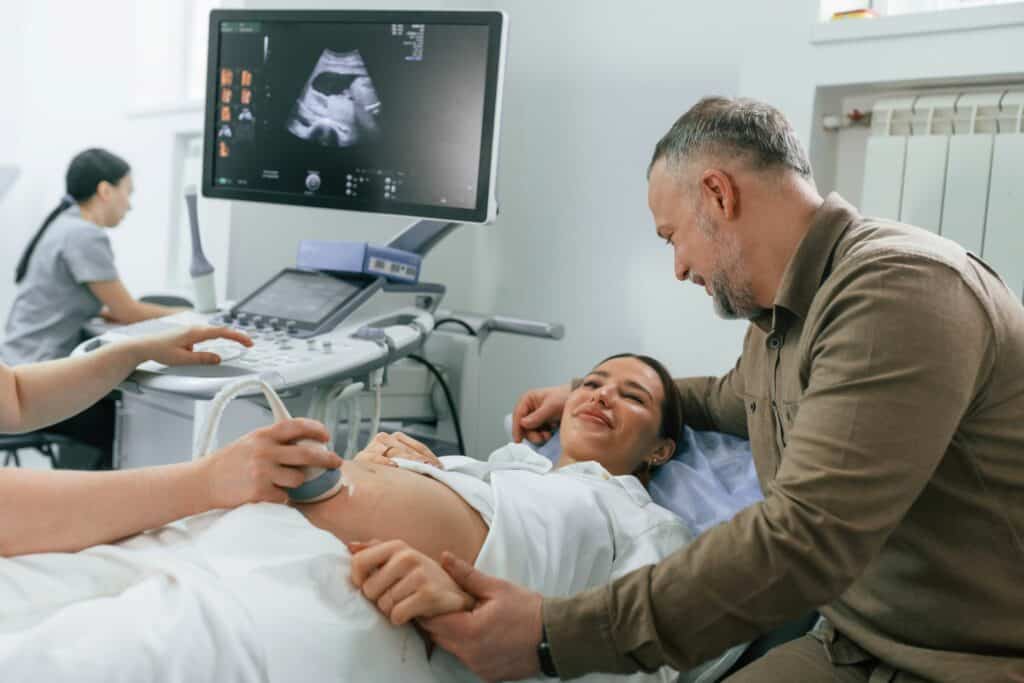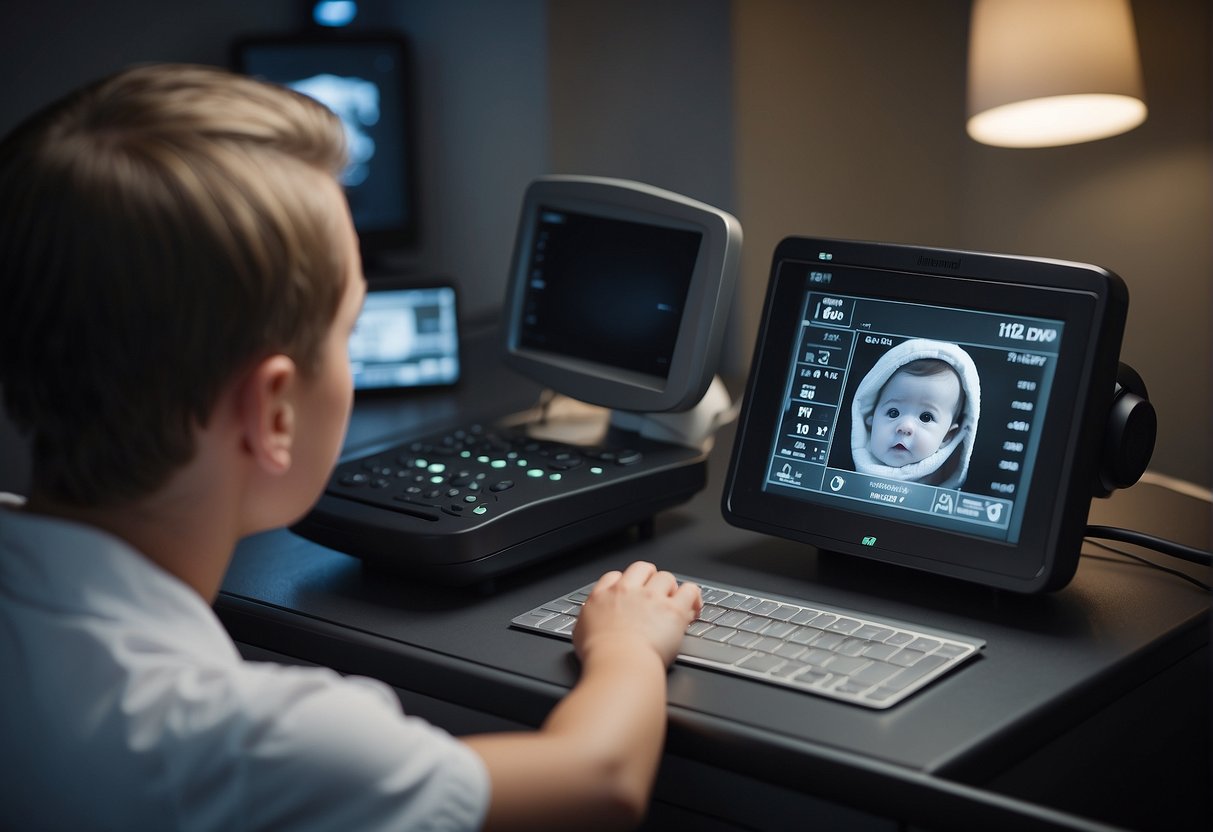Ultrasound is a common diagnostic tool used during pregnancy to assess fetal growth and development. It allows parents-to-be to see their baby’s features and movements before birth. However, some parents may be concerned when they see their baby’s nose looking disproportionately large on the ultrasound screen. This article will explore the reasons why a baby’s nose may appear big on an ultrasound and provide reassurance to parents.
Understanding Ultrasound Basics
Ultrasound uses high-frequency sound waves to create images of the developing fetus. The sound waves bounce off the baby’s tissues and organs and are detected by the ultrasound machine. The machine then converts the sound waves into images that can be seen on a screen. Ultrasound is a safe and non-invasive procedure that does not use radiation.
Interpreting Facial Features on Ultrasound
Ultrasound images can provide a detailed view of the baby’s facial features, including the nose. However, the position of the baby, the angle of the ultrasound probe, and the quality of the image can all affect the appearance of the nose. In some cases, the nose may appear larger or more prominent due to the angle of the ultrasound probe or the position of the baby’s head. In other cases, the image may be distorted due to the baby’s position or movement.
Key Takeaways
- Ultrasound uses sound waves to create images of the developing fetus.
- The position of the baby, the angle of the ultrasound probe, and the quality of the image can all affect the appearance of the nose on ultrasound.
- A large or prominent nose on ultrasound does not necessarily indicate a problem with the baby’s health.
Understanding Ultrasound Basics
Ultrasound Technology and Sound Waves
Ultrasound technology uses high-frequency sound waves to create images of the inside of the body. These sound waves are sent into the body and bounce back to the ultrasound machine, where they are translated into images. The sound waves used in ultrasound are too high for humans to hear, but they can be detected by special equipment.
Ultrasound technology has been used for many years in medical settings to diagnose and monitor a range of conditions. It is safe and non-invasive, making it a popular choice for doctors and patients alike.
The Role of Ultrasound in Pregnancy
Ultrasound is commonly used during pregnancy to monitor the growth and development of the fetus. It can also be used to detect any potential problems, such as birth defects or other abnormalities.
There are two main types of ultrasound used during pregnancy: 2D and 3D. 2D ultrasounds create a flat, two-dimensional image of the fetus, while 3D ultrasounds create a three-dimensional image. 4D ultrasounds are similar to 3D ultrasounds, but they also show movement.
Ultrasound technicians are trained professionals who operate the ultrasound equipment and interpret the images. They work closely with doctors and other medical professionals to ensure that the ultrasound is performed safely and accurately.
Overall, ultrasound technology is an important tool in the diagnosis and monitoring of pregnancy. It allows doctors to detect potential problems early on and take appropriate action to ensure the health of both the mother and the baby.
Interpreting Facial Features on Ultrasound
Ultrasound technology is a valuable tool for monitoring the growth and development of a fetus during pregnancy. However, the images produced by ultrasound can be difficult to interpret, especially when it comes to facial features.
Distortion and Angle Effects
One common concern among expectant parents is the appearance of their baby’s nose on ultrasound. It is not uncommon for a baby’s nose to appear larger or distorted on ultrasound images. This can be due to a variety of factors, including the angle of the ultrasound transducer, the amount of amniotic fluid present, and the position of the baby’s head.
The angle of the ultrasound transducer can have a significant impact on the appearance of a baby’s facial features. If the transducer is not positioned correctly, it can create an optical illusion that makes the nose appear larger than it actually is. Similarly, if there is not enough amniotic fluid present, the baby’s face can become compressed, which can also distort the appearance of the nose and other facial features.
Development of Facial Features
It is important to keep in mind that fetal development is a complex process, and the features of a baby’s face can change rapidly during pregnancy. For example, the nasal passage may appear larger than normal during early stages of development, but will typically decrease in size as the pregnancy progresses. Additionally, the lips and other facial features may appear larger or smaller than normal depending on the stage of development.
Overall, it is important to remember that ultrasound images are not always an accurate representation of a baby’s appearance. While they can provide valuable information about fetal development, they should not be relied upon as the sole indicator of a baby’s health or physical appearance. If you have any concerns about the appearance of your baby’s facial features on ultrasound, it is important to discuss them with your healthcare provider.
Factors Affecting Ultrasound Images
Ultrasound is a medical imaging technique that uses high-frequency sound waves to produce images of the inside of the body. Although ultrasound is generally safe and non-invasive, the quality of the ultrasound images can be affected by several factors.
Fluid and Pressure Impact
One of the primary factors that can affect the quality of ultrasound images is the amount of fluid and pressure in the uterus. The more fluid there is in the uterus, the clearer the ultrasound images will be. On the other hand, if there is not enough fluid, the images may appear blurry or difficult to interpret. Additionally, the pressure of the uterus can also impact the quality of the images. If the uterus is swollen or pressing against the uterine wall, it can be more difficult to obtain clear images.
Baby’s Position and Movement
Another factor that can impact the quality of ultrasound images is the position and movement of the baby. If the baby is not in an optimal position, it can be difficult to obtain clear images. For example, if the baby is facing away from the ultrasound probe, the images may be less clear. Similarly, if the baby is moving around too much, it can be challenging to capture clear images. In such cases, the sonographer may ask the mother to change positions or take a break to allow the baby to settle down.
In conclusion, several factors can impact the quality of ultrasound images, including the amount of fluid and pressure in the uterus and the position and movement of the baby. It is essential to understand these factors to ensure that the ultrasound images are as clear and accurate as possible.
Common Concerns and Reassurances
Addressing Parental Worries
It is common for parents to be concerned when they see their baby’s nose appearing larger than usual on an ultrasound. However, parents should not worry too much as it is normal for a baby’s nose to look big on a 3D ultrasound due to various factors such as faulty sound waves, bad angles, or the baby being squished. According to Parents Wonder, in rare cases, a large or flattened nose can indicate genetic abnormalities. However, parents should not jump to conclusions and should consult their doctor if they have any concerns.
When to Consult a Healthcare Provider
If parents are concerned about their ultrasound pictures, it is best to consult with their sonographer and doctor. According to Parental Questions, a 3D or 4D scan can show parents what their baby might look like and how they are doing inside the womb. The benefit of a 3D or 4D scan for most moms is that they can see their baby in the womb. However, if parents are worried about their baby’s health, they should not hesitate to consult with their healthcare provider.
In summary, while it is normal for a baby’s nose to look big on an ultrasound, parents should not hesitate to consult with their healthcare provider if they have any concerns about their baby’s health or development.
Beyond the Ultrasound
Preparing for Baby’s Arrival
Once the ultrasound is complete, parents-to-be may begin to worry about their baby’s appearance. However, it’s important to remember that the ultrasound is just a tool used to monitor the baby’s growth and development. It’s not a perfect representation of what the baby will look like at birth.
In preparation for the baby’s arrival, parents may want to research baby products and create a registry. Many online retailers offer registry builders that make it easy to create a list of items needed for the baby. Parents can also join registry communities to get advice from other parents and share their own experiences.
Post-Delivery Expectations
After the baby is born, it’s normal for parents to have expectations about what their baby will look like. However, it’s important to remember that every baby is unique and may not meet those expectations.
Parents may also be thinking about baby names. It’s a good idea to have a few options picked out before the baby is born. This can make it easier to decide on a name once the baby arrives.
In terms of the baby’s appearance, it’s important to remember that newborns may have features that are different from what parents expect. For example, a baby’s nose may look bigger or smaller than expected. This is normal and the baby’s appearance may change as they grow.
Overall, it’s important for parents to focus on the health and well-being of their baby, rather than their appearance. By preparing for the baby’s arrival and keeping realistic expectations, parents can enjoy the experience of welcoming their new addition into the world.
Frequently Asked Questions
Why do features like my baby’s nose appear exaggerated on a 3D ultrasound?
According to Parental Questions, 3D ultrasounds use sound waves to create a three-dimensional image of the developing fetus. These images can sometimes appear distorted, especially when it comes to facial features. One reason for this is that the baby’s face is often pressed up against the uterine wall, which can cause the nose to appear larger than it actually is.
Can an ultrasound accurately predict the size of my baby’s nose at birth?
It is important to note that an ultrasound is not a perfect predictor of a baby’s appearance at birth. While it may give a general idea of what the baby will look like, it is not always accurate. According to My Milky Baby, the size and shape of a baby’s nose can change significantly in the weeks and months leading up to birth. Therefore, it is best not to rely too heavily on ultrasound images when trying to predict a baby’s appearance.
Is it normal for my baby’s nose to look squished on a 2D ultrasound image?
Yes, it is normal for a baby’s nose to appear flattened or squished on a 2D ultrasound image. This is because 2D ultrasounds use sound waves to create a two-dimensional image of the developing fetus. According to Parents Wonder, the angle and position of the ultrasound probe can also affect the appearance of the baby’s nose.
How do facial distortions on ultrasound images, such as a pointy nose, occur?
Facial distortions on ultrasound images can occur for a variety of reasons. According to Parental Questions, one reason is that the sound waves used to create the image may not be able to penetrate certain areas of the developing fetus, resulting in a distorted image. Additionally, the position of the baby, the position of the ultrasound probe, and the angle of the image can all affect how facial features appear on the ultrasound.
What factors can lead to a baby’s nose looking larger on an ultrasound?
There are a few factors that can lead to a baby’s nose looking larger on an ultrasound. According to Medicalert Systems, these include the position of the baby, the angle of the ultrasound probe, and the quality of the ultrasound machine. Additionally, the size and shape of the mother’s uterus can also play a role in how the baby appears on the ultrasound.
Are the facial features seen in an ultrasound, like the nose, a reliable indicator of my baby’s appearance?
While ultrasound images can give a general idea of what a baby will look like, they are not always a reliable indicator of a baby’s appearance. According to My Milky Baby, the size and shape of a baby’s nose can change significantly in the weeks and months leading up to birth. Additionally, other factors such as genetics, environmental factors, and the baby’s health can all affect how a baby looks at birth. Therefore, it is best not to rely too heavily on ultrasound images when trying to predict a baby’s appearance.

My name is Laura, and as a mother of two, I understand firsthand the joys and challenges of raising a child. That’s why I created this website, to provide a comprehensive and trustworthy source of information and support for new and expectant parents.






